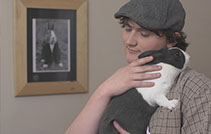A Little Help (ALH) is the second web series
produced by the Media, Journalism and Film (MJF) department at Missouri State University. The ALH production team is comprised of many talented people in the College of Arts and Letters, including both graduate and undergraduate students from media production, digital film, electronic arts, graphic design, journalism, communication, public relations and the interdisciplinary degree program.
Much of MJF faculty and staff have provided guidance and support by both monetary means and technical expertise. The series was filmed on AF100 cameras with a Tricaster field unit for multi-camera production and edited with Avid software.
A Little Help’s cast is comprised of both students and faculty from the Theatre and Dance department at Missouri State University, and actors from the Springfield community.
The A Little Help web series is a departure from the expanse of Epilogue, MJF’s first award winning series. Instead of the series being written by a team of students, ALH was created by screenwriting graduate student Kevin Shabel and was adapted to be a web series by Kevin and digital film senior Nich Peltz.
Instead of a six-part science-fiction time travel series shot mainly at two locations, we chose a four episode comedy shot at multiple locations. Instead of a lot of visual effects, this one had children and rabbits!
No matter the challenge, the cast and crew’s energy inspired a fun and collaborative work atmosphere,
which was imperative since the production shot 130 hours over the course of Spring Break in March 2014 and have since logged double that amount in post-production to truly polish A Little Help.
Diana Dru Botsford & Dr. Deborah Larson
Creating the web series model was pioneered by two MJF professors, Diana Dru Botsford and Deborah L. Larson. Screenwriting professor Diana had a vision to create a more “real world” experience for the students by mapping out an 18 month pre-production, production and post-production schedule. The executive producers create the parameters and then a group of student writers write the script and edit the episodes together so it flows. Once written, Dr Larson’s Advanced Television class grows triple its normal size to implement the Instructional Scaffolding (IS) model emulating a real world production experience.
Using IS, a tiered role model approach is created for deeper learning. Students had to apply to be ‘hired’ on for a crew position onto the team of 50 people. Faculty serve as hands-on mentors. Graduate students, non-traditional, and more experienced undergraduates make up the department heads on the crew. Juniors/Seniors take on crew position in their areas of interest, (e.g., camera, sound, editing) and Freshmen/Sophomores participate as PAs, boom ops and extras. Each person holds one essential job that he/she does very well. This approach is very different from our smaller digital film and television production capstone courses where 15 people do multiple jobs on a production set.
Television is a producer’s medium rather than a director’s medium and the web series follow that logic. The producers stay very active in the process to serve the vision of the script, maintain the integrity of the production, and keep consistency between multiple episodes and multiple directors. Both Epilogue and A Little Help have maintained the IS model and the process seems to be working in terms of an increase in knowledge base about how production works, applied production experience, and student learning outcomes. So much so, the MJF department is now changing the way we approach all our capstone projects. A double success story so far!
ACADEMIC MEDIA PRODUCTION GUILD
AMPG was created to AMPLIFY THE CREATIVE SPARK! In other words, to give students a better understanding of what it takes to produce a media production through creative leadership, raising money, and doing project planning and management.
AMPG was created to help students collaborate among all media makers including writers, producers, directors, cinematographers, crew, graphic artists, web designers, animators, audio specialists, art department experts, journalists, and other communication specialists.
AMPG essentially serves as a link between the passionate creative spark and finding the path to produce your vision. AMPG welcomes all majors and areas of expertise.
FILL THE FORM BELOW
FOLLOW ON YOUR FAVORITE
Copyright © 2014 - All Rights Reserved














